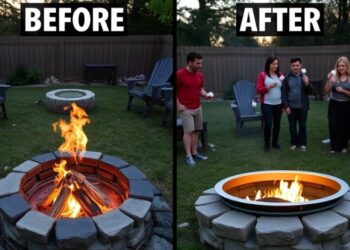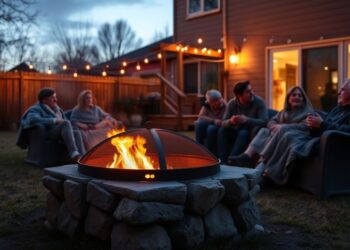Discover everything about smokeless fire pit rings, design, benefits, materials, and expert tips for a cleaner, warmer fire.
You’ve probably seen ads promising “a fire without smoke” and thought, Yeah right, and my grill cleans itself too. But here’s the thing, smokeless fire pit rings actually work. They aren’t magic; they’re an elegant application of airflow dynamics, material science, and a bit of human stubbornness to make fire better.
If you’ve ever been on the losing side of the smoke that follows beauty myth (meaning it follows you no matter where you sit), you already know the pain of traditional fire pits. The sting in your eyes. The smell baked into your clothes for days. The constant musical chairs trying to escape the smoke.
A smokeless fire pit ring changes that, not by eliminating smoke completely, but by reducing it to the point you’ll forget it’s there. And in this guide, we’re digging into exactly how that’s possible, what to look for, and how to choose one that fits your style, space, and sanity.
What You'll Discover:
The Science Behind the Smoke (and How These Rings Outsmart It)
Before you buy anything, you should understand what’s really happening when wood burns, and more importantly, when it smokes.
- Incomplete combustion is the villain here. Smoke is essentially unburnt particles, tiny pieces of carbon, water vapor, and organic compounds.
- This happens when fire doesn’t get enough oxygen or isn’t hot enough to burn everything fully.
The smokeless fire pit ring works by creating a secondary combustion. Here’s the breakdown:
Dual Airflow Design
- Primary air feeds the base of the fire from underneath, keeping the main burn hot.
- Secondary air is preheated as it travels through hollow walls of the ring, then injected into the top of the flame.
- This extra oxygen burns off smoke particles before they escape into the air.
Result
You get a hotter, cleaner burn with less visible smoke, without any need for special fuel or constant poking.
Why You Might Actually Need One (Beyond the Obvious)
Sure, “less smoke” sounds great, but the benefits stretch further than comfort.
Cleaner Air Around the Fire
If you’ve got kids, elderly relatives, or friends with asthma, the reduced particulate matter means fewer respiratory irritants floating around.
Better Heat Output
By burning more completely, the fire generates more heat per log. That’s not just cozy, it’s efficient.
Fuel Efficiency
Since less energy is wasted as smoke, you’ll need fewer logs to keep the fire going. Over time, that’s a real cost saver.
Less Mess in the Morning
Ash from complete combustion is finer and easier to clean than the clumpy leftovers of smoky fires.
Types of Smokeless Fire Pit Rings You’ll See Out There
Not all smokeless fire pit rings are created equal. You’ll come across a few main categories:
Built-In Rings for Permanent Fire Pits
Perfect if you’re designing a custom backyard feature. They integrate seamlessly with stone or brickwork.
Standalone Portable Rings
Lightweight, often stainless steel, great for camping or tailgating.
DIY-Optimized Rings
These are designed for people who want to retrofit their existing fire pits with smokeless capability.
Materials Matter, A Lot
A fire pit ring lives in a hostile environment: high heat, thermal cycling, moisture, and sometimes corrosive ash. The choice of material can make or break its performance and lifespan.
Stainless Steel (304 or 316 Grade)
- Pros: Corrosion-resistant, retains strength at high temps, easy to clean.
- Cons: Higher cost.
Carbon Steel
- Pros: Strong, cheaper than stainless.
- Cons: Needs maintenance (can rust if left exposed).
Cast Iron
- Pros: Holds heat well, great for even cooking if used with grills.
- Cons: Very heavy, prone to rust without care.
Size Isn’t Just About Looks
A too-small ring will choke airflow, while a too-large one might waste heat and fuel.
- For small patios: 19–22 inches in diameter works well.
- For larger gatherings: 27–30 inches keeps everyone warm without overcrowding.
- For camping: Compact, under 20 inches, for easy transport.
How to Spot a Well-Designed Smokeless Fire Pit Ring
You can tell a lot about quality from these features:
- Consistent gap size for secondary air vents. Uneven holes = uneven burn.
- Double-wall construction for better preheating of secondary air.
- Smooth welds, sloppy welds mean sloppy airflow.
- Drainage holes to prevent rainwater pooling in the ring.
DIY Smokeless Fire Pit Ring, Worth It or Waste of Time?
You can absolutely build one yourself if you’re comfortable cutting and welding steel. The trickiest part is ensuring precise airflow. Mess that up, and you’ll have a fancy, heavy smoke machine.
For most people, buying a pre-engineered ring is worth it, especially if you factor in the cost of materials and tools. But if you’re the type who enjoys weekend welding projects, it can be satisfying to make your own.
Placement and Setup Tips for Maximum Smokelessness
Even the best ring can smoke like an old diesel engine if you misuse it.
- Location: Choose an open area with no overhanging branches. Poor ventilation kills secondary combustion.
- Fuel: Use seasoned hardwood, not softwood or freshly cut logs. Moisture = more smoke.
- Stacking: Avoid throwing logs in randomly. Leave airflow paths between pieces.
- Start hot: Begin with a kindling-heavy base to bring temps up quickly.
Examples That Prove It Works
- Backyard test: Two identical pits, one with a smokeless ring, one without. The standard pit had visible smoke after 2 minutes; the smokeless pit showed barely any after the same time.
- Camping scenario: Smokeless rings meant people could sit in a circle without constantly shifting chairs to dodge smoke plumes.
- Urban rooftop: Reduced smoke kept neighbors from complaining about “burning smells.”
Maintenance, Because It’s Not a “Set It and Forget It” Item
- After each burn: Shake out ash once cool.
- Monthly: Check for creosote buildup in vents.
- Annually: Inspect welds and metal for cracks or rust spots.
Neglect this, and performance will drop fast.
A Quick Word on Cost
You can spend anywhere from $80 to $500 on a smokeless fire pit ring. The difference?
- Budget rings often have thin metal, fewer vents, and no double wall.
- Premium models offer thicker steel, precise engineering, and better heat retention.
In other words, pay more now, or pay more later replacing it.
Key Takings
- Smokeless fire pit rings cut down on smoke by using secondary combustion, making fires cleaner and hotter.
- Stainless steel offers the best durability, though it comes at a higher price.
- Correct size and airflow are critical for performance.
- Proper fuel choice and stacking method affect smokeless efficiency as much as the ring’s design.
- DIY builds are possible but require precision; for most people, buying is the better option.
- Maintenance is essential, neglect it, and your smokeless ring won’t stay smokeless.
- Invest in quality materials if you want a long-lasting, efficient outdoor fire experience.





